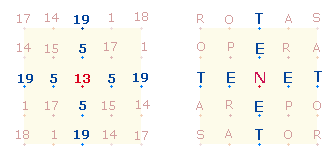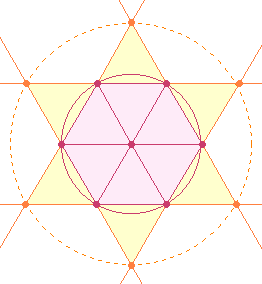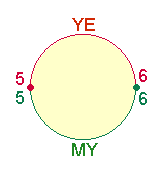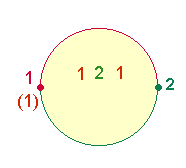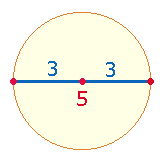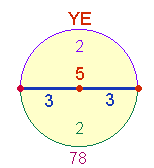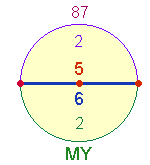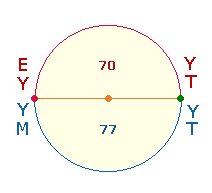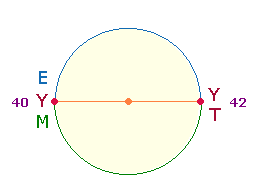back
Alphabets;
factoral values
Shakespeare's Epitaph
E. Gematric
Meaning of the 4 Y-Words
F. Values of y-words combined with
SATOR Square
G. Greek Y-words in
the Angel's Annunciation Speech
K. Shakespeare
understands himself as Mary's Son
|
6 |
GOOD FREND FOR IESVS SAKE FORBEARE |
|
6 |
TO DIGG THE DVST ENCLOASED HEARE. |
|
8 |
BLESTE BE YE MAN YT SPARES THES STONES |
|
8 |
AND CVRST BE HE
YT MOVES MY BONES. |
I. Numeric values of
Y-words and word positions
II. The 4values of Y-words and word positions
III. Two semicircles
I. Numeric values of
Y-words and word positions
1. It is striking that the
letter Y occurs in four two-letter words. Furthermore, each pair is
separated by one word, which gives them a concentric symmetry: YE and MY take the positions 15 and 27, the two YT the positions 17 and 25, which make 42 for one pair. The
total sum of the 4 positions is 84 = 4*21.
Two more things are
remarkable: YT occurs twice as the central word pair, and the first word starts with
Y, the last ends with
it.
2.
The four words have the following numeric values (NS):
|
|
YE |
YT |
YT |
MY |
sm. |
|
NS |
28 |
42 |
42 |
35 |
147 |
|
147 = 7*21 |
|||||
Remarkably, all four NS are divisible by 7.
As the word positions
are symmetrical, we can suppose that Shakespeare wanted the NS of the symmetrical
words to be connected as well: 28+35 = 63; 42+42 = 84; 63:84 = 21*(3:4).
Shakespeare obviously
wanted to establish a numeric ratio between the word positions and the numeric
sum (NS). The ratio 84:147 is 21*(4:7) = 21*11 =
231. If we
add up the values of the two concentric pairs, the ratio is (63+42):(84+42) = 105:126 = 21*(5:6). Both ratios are
divisible by 21 and the factor 11 has two different compositions.
231 is the sum of the
numbers 1-21, the letters of the Latin alphabet.
3.
It looks as if Shakespeare pursued a complex concept which
to expound would be too long. I therefore confine myself to two aspects, proceeding
mathematically on the basis of the result so far gained.
II. The 4values of Y-words and word positions
1.
If Shakespeare connected the sum of word positions from 1 to 28 with the NS 1242 of the epitaph, the
result was 14*29 = 406+1242 = 1648 = 16*103. In this way SHAKESPEARE achieved the NS 103 of his name to
dominate his entire epitaph.
If 231 is
subtracted from 1648, the factors of the result 1417 are 13*109 which point to the NS 109 of the TENET Cross:
|
|
The NS of one TENET is 61, doubled 122. But if the N in the centre is
counted only once, the sum is 109. Both sums 109+122 = 231 are identical with the
NS
147 of the
Y-words + the sum of word
positions 84.
2.
What expects us if we extend this double calculation to
the FS and the 4values?
|
|
NS |
FS |
sm |
FV1 |
FV2 |
sm |
total |
|
text |
1224 |
971 |
2213 |
34 |
971 |
1005 |
3218 |
|
1-28 |
406 |
255 |
661 |
38 |
25 |
63 |
724 |
|
sm |
1648 |
1226 |
2874 |
72 |
996 |
1068 |
3942 |
|
3942 = 54*73;
1224:2700 = 54*( |
|||||||
|
1068:2874
= 6*(178:479) = 6*657 |
|||||||
The NS+FS 2874 is
a rare gematric example of 4-digit number which contains the four
distinguishable elements of a double-rhombus: 7 points, 8+2 lines, 4
triangular areas.
The total result 3942 is divisible by 54 like the NS 1224 of the epitaph.
3.
We now enter into deeper geometrical implications and the
religious mysteries of the epitaph. 72 is the NS+FS of MARIA, 63 the NS of Greek YIOS – son, 178 the NS+FS of IESUS and MARIA.
If we add the two FV1 72 to 1242,
3:5 values yield the
result 1314 = 18*73, which is one third of the total result 3942. 73 is the NS of Latin FILIUS – son. So MARIA exerts three
influences: She effects universal order and harmony,
and, by assisting Shakespeare, she gives him her son Jesus.
Accordingly, 2700-72 = 2628 is double the sum of 1314. The number 2628 is very remarkable: It is
divisible by 54, which is the sum of 26+28. There seems to exist a deeper sense in Ovid's 26 and Shakespeare's 28 words of their
epitaphs, of which Shakespeare must have been well aware. The two numbers can
be explained by the composition of the hexagram with its two concentric
circles.
We must start with the second
number 28. The circle as the basis of the hexagon consists of 3 elements: midpoint,
arc, and area. The hexagon itself consists of 25 elements, including
the midpoint of the circle. By extending the 6 segmental lines of the
hexagon, the hexagram is created:
|
|
The extension process adds 24 more elements. If the
surplus midpoint serves to draw a second arc around the hexagram, the circular
line and the area that is created are additional 2 elements. The area
added is double the size of the hexagonal circle area.
4.
If we deal with the NS+FS and the FV1/2 sums separately, the NS/FV-calculation produces
the following result:
|
|
NS+FS |
FV1/2 |
sm |
FW |
sm |
|
ZS |
2874 |
1068 |
3942 |
84 |
|
|
FW |
484 |
96 |
580 |
38 |
|
|
sm |
|
|
4522 |
122 |
|
|
FW |
|
|
45 |
63 |
108 |
|
4522 =
2*7*17*19 |
|||||
One curious fact is that the FV 63 of the 4v-sum 122 of (H)YIOS
is also its NS. The numbers 45 and 63 are just the NS of
what Shakespeare intended the word MY to mean: MARIAE YIOS – Mary's son.
1.
Shakespeare's intention to arrange the four y-words on the
beginning and end of two semicircles becomes evident if we look at their 4values:
|
YE |
28 |
28 |
56 |
11 |
11 |
22 |
78 |
|
YT |
42 |
42 |
84 |
12 |
12 |
24 |
108 |
|
YT |
42 |
42 |
84 |
12 |
12 |
24 |
108 |
|
MY |
35 |
30 |
65 |
12 |
10 |
22 |
87 |
|
sm |
147 |
142 |
289 |
47 |
45 |
92 |
381 |
The NS+FS of YE and MY are the palindromic numbers 56 and 65 which added up amount to 121. Two semicircle symbolize two phases of a total circuit, like day
and night, caused by the apparent revolution of the sun. The second phase leads
back to the beginning. This can be defined by the first two numbers 1 and 2:
|
|
|
The numbers 5 and 6 characterise the axis
of a circle which consists of 5 elements, the midpoint, two circle line points and
two radial lines. A singular radius, however consists
of a lineal measure delimited by two points. Two radii therefore require two
midpoints, the result is 6 elements:
|
|
The circle axis creates two
elements a semicircle, a semi-arc and one half of the circle area. These 2+2 elements can be
represented by the FV1/2 sums 22 of YE and MY, so that their 4v-sums 78 and 87 are again
palindromes:
|
|
|
2.
The 5 diametric and 3+3 radial elements are a
central religious concern of Shakespeare's: The NS of IESUS is 70 = 2*35 and the NS+FS is
70+36
= 106 = 2*53. If the word MY stands for MARY, the two NS are 35 and 53.
3.
The four Y-words can be arranged on the two semicircles in
the following way:
|
|
|
In the first graphic
two words mark one semicircle, in the second doublings are removed.
There is a ratio of the left and
right NS+FS:
|
LEFT
POINT |
RIGHT
POINT |
||||||||
|
4 letters |
3 letters |
|
4 letters |
2 letters |
|
||||
|
NV |
FV |
NV |
FV |
|
NV |
FV |
NV |
FV |
|
|
63 |
58 |
40 |
35 |
196 |
84 |
84 |
42 |
42 |
252 |
|
196:252 =
28*(7:9) = 448 |
|||||||||
More about the two circles is to be
found in the article: Shakespeare understands himself as Mary's son. I've also kept the older
article from 2009 on the Y-Words in the internet.
EARLIER STUDIES:
C. References to
IESUS CHRISTUS and VESTA
D. VESTA and
IESVS – Two Complementary Models
Written: January 2009
Shortened and revised: June 2014
